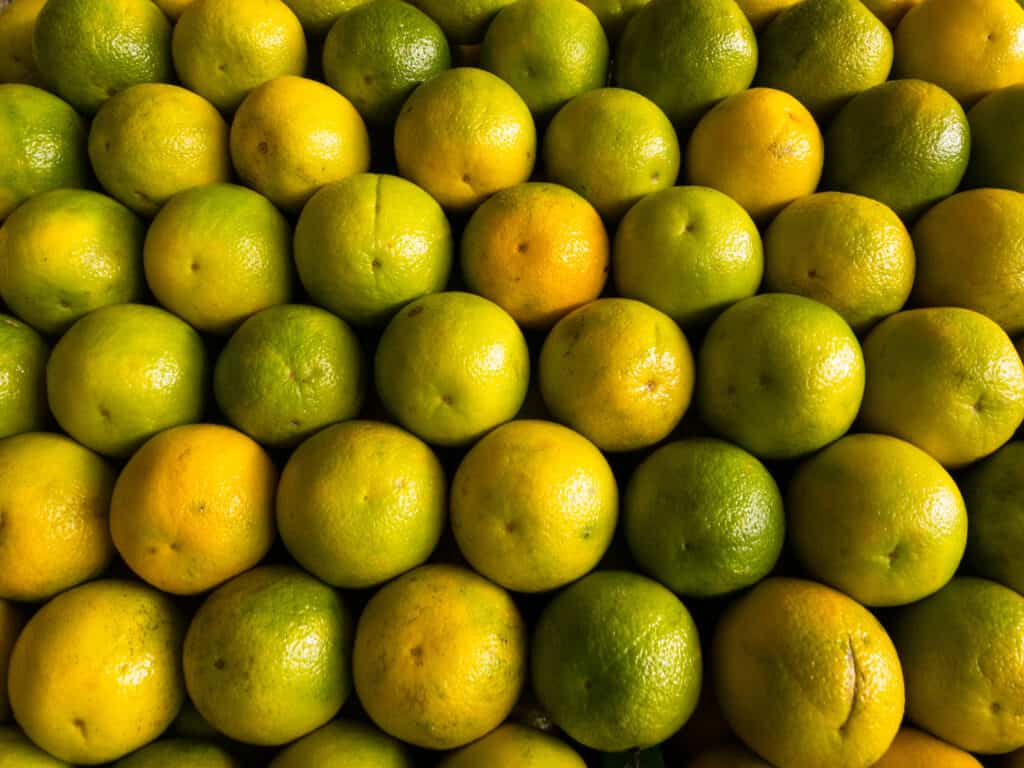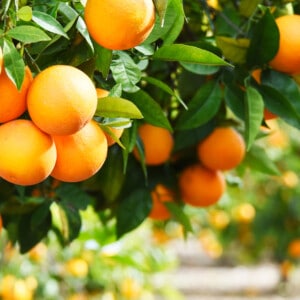Oranges are a popular fruit around the world due to their flavor and accessibility. They carry a ton of great nutrients, including Vitamin C and antioxidants, and are pretty easy to eat.
Did you know there are hundreds of orange varieties around the world? Many are native to local areas and hard to find outside their natural habitat, but there are more than you probably realize you can easily try. These less typical oranges have different colors, flavor profiles, and overall eating experiences. This article breaks down the top 10 different varieties of oranges you should try.
You can find these oranges in grocery stores depending on the time of year, which I share below. Some types might only be found at specialty locations, but this guide will give insight into how diverse the variety of orange really is.
Where are oranges grown?
In the U.S., the top states to grow oranges are California, Florida, Texas, and Arizona. Florida produces the most oranges— estimates suggest 90% of U.S. orange juice is sourced from Florida. Outside the U.S., Brazil and China are the largest producers of oranges.
Varieties of Available Oranges
While there are around 400 different varieties of oranges around the world, we will cover a few of the most popular and widely available to the average consumer in the list below:
1. Navel Orange
The Navel orange is a winter orange with thick orange skin and sweet fruit. The fruit is seedless and comprises about a dozen sections held together by the orange’s peel. These oranges are known for their sweetness and Vitamin C content and are popular due to how enjoyable of an eating experience they provide.
The fruit is native to Brazil, but states like California and Florida also grow them. The peak of their season is from November through January—it’s when they’re sweetest and bursting with fresh citrus aroma.
2. Cara Cara Oranges
Cara Cara oranges are a cross-breed of two types of navel oranges. They share the same bright orange flesh as a standard navel orange but also have an interior flesh bursting with pinkish-red color. These oranges are sweet but do have a slight tang when eating them. They carry slight berry notes and are a little less acidic than your standard orange.
Their season runs from December to April, and this is the best time to eat the variety. They are a dominant variety in California and are popular in the state because they can adapt across different micro-climate zones while still producing high-quality fruit. They are easier to maintain over other citrus varietals and are an excellent choice when looking for a sweet and slightly tangy flavor in your orange.
3. Blood Orange
Do not let the name fool you, as the name itself is the ugliest part of this beautiful orange. Blood Oranges have thicker rinds, are smaller than a standard navel orange, and tend to have a red blush on their outer skin. When cut open, they reveal a dark red flesh that is truly beautiful and appetizing in the best way. This dark red flesh gives them their name, “blood orange.”
This orange is popular in many culinary applications due to its iconic color and flavor. Expect notes of raspberries and blackberries when eating this orange, plus notes of balanced sweetness and tartness. These oranges thrive in Mediterranean climates like Italy, Spain, and Malta. Many dishes from these regions utilize blood oranges for this reason.
4. Seville Orange
The Seville orange is an orange that is unique in the fact that it is actually very sour. It has a thick rind and a tangy and sour taste that can also be quite bitter. They are not commonly used as snacking oranges and are sometimes called “Sour Oranges” due to their strong sour flavor profile.
Native to Southeast Asia, these oranges found their way to Spain, where they are now primarily grown. Look to use them in cocktails, cooking sauces, baked goods, and other food applications where a tangy and sour citrus note is needed to balance out that item. Their season is often late winter to early spring, depending on geographic region.
5. Valencia Oranges
A variety popular for juicing, Valencia oranges are known for being full of juice and having very thin skins. This type of orange is popular for juicing due to its lower-than-average amounts of Limonin, which is a compound in most oranges that can cause the juice to become bitter when exposed to air. This, plus a very sweet profile, makes it the ideal juicing orange around the globe.
These oranges are in season from March to September, in which they will contain the most juice and freshest flavor. They are grown widely across several regions, but most agree this orange got its popularity in California. They are different due to being available in the summer than in the winter, so they make for a refreshing snack during hot summer months.
6. Bergamot Orange
A big departure from this list, Bergamot oranges are actually a bright yellow color when fully ripe. They have a medium-sized rind with pale yellow flesh. These oranges are extremely sour and are not meant to be eaten fresh. Their flesh is not even the main part many look to use, but rather the peel is what is often sought out. The peel is floral and has a unique aroma that is highly popular in teas and other flavorings.
Available in early fall through the winter, they are heavily produced in Italy. They can be found elsewhere, but Italy is the primary source. Calabria, Italy, is known as the landmark location for growing these oranges. The oils from the peel are used in colognes and even help flavor Earl gray teas. The Bergamot orange is unique, but the flavors pulled from its peel make it a standout orange on this list.
https://www.pinterest.com/pin/1119074207380796635/
7. Trifoliate Orange
This orange is another unique variety. It’s bitter and grown in the Southern United States, though it’s native to Northern China. This orange has a fuzzy, yellow rind with very little pulp and a ton of large seeds. The juice from this orange can be used in cocktails, marmalades, and marinades due to its strong citrus and floral profile.
The useful part of the Trifoliate plant is that it’s used in livestock management and pest deterrence. The tree grows branches with long thorns on them. The branches twist and knot around each other and can be planted strategically to be a natural barrier.
8. Jaffa Orange
Also known as Shamouti Orange, this orange is native to Jaffa, Israel. It was popular among trade routes due to its tougher skin in transport while also being easy to peel. Though not as juicy as a Valencia, these oranges are much sweeter, making them an excellent snacking orange. They’re in season between November and March, so be sure to look out for them during this time of year.
The oranges themselves used to be Israel’s most famous export but have since declined in both their growing and volume of stock on hand. They were embroiled in many political arguments and have since lost the popularity they held in the 19th century. They are a delicious snacking orange and worth trying if you have access to them.

9. Lima Oranges
Lima oranges have a bright orange exterior, pale orange flesh, and cream-colored seeds. What makes these oranges so unique is that they are acid-less, offering a sweet and enticing flavor upon eating. They are available from the late winter into early spring. They have a short shelf life due to the lack of acid and are best enjoyed as soon as possible.
They are known to be grown heavily in Brazil and are often celebrated as one of the favorite oranges the country has access to. They are mainly used for snacking and as a finishing juice on different culinary dishes and desserts. Due to the low acidity, this orange is often given to infants, the elderly, or those with digestive issues.
10. Mandarin Oranges
Wait, the last orange on this list is not technically an orange? As confusing as it can be, the Mandarin is a close cousin to the standard orange. They are smaller and often sweeter options than most other oranges. Their flavor and size are what make them popular, as segments of the orange find their way into dishes, and the juice itself can be used in both sweet and savory applications.
They are native to China but are also heavily grown in the United States. The main season for this citrus family is between November and April. The Mandarin family also has fruits such as Clementines, Tangerines, and Kumquats. Mandarins are a great subset of citrus fruits that mimic the flavor of an orange, all with their unique discerning qualities.
Why are oranges available year round?
As we pointed out in this article, different varieties of oranges have different seasonality. The U.S. can grow and import different varieties available around certain times of the year. California also delivers a climate with a much longer growing season for most orange varietals.
What are the different parts of an orange?
Oranges typically comprise an outer peel, a fibrous layer, juicy flesh, and a core. These different parts all have culinary uses, dependent on the type of orange variety you are working with.
Which country imports the most oranges?
In 2021, Germany was the largest importer of oranges in the entire world.
10 of the Best Types of Oranges

Ingredients
Instructions
- Pick the variety that interests you most.
- Determine what the best time of the year is for that orange.
- Purchase at your local grocery or specialty grocery store.
- Enjoy!


I tried a murcott for the first time today at sherms and it is the best orange I’ve ever tasted!